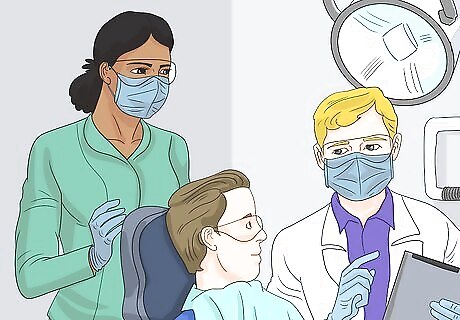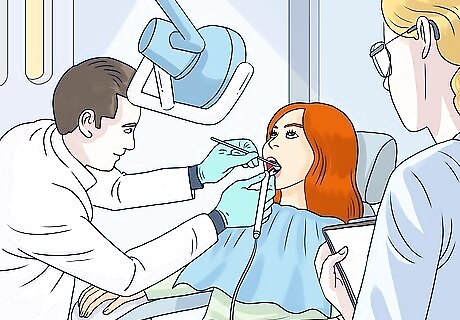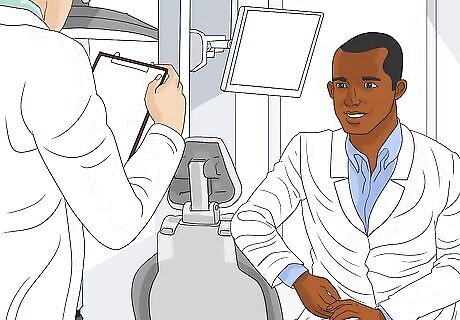
views
- Get a bachelor's degree in pre-dentistry or a related science, then go to dentistry school for 4 years to earn your doctorate in dentistry.
- Pass the national written exam and clinical exams so you can apply for licensure in the state where you want to practice.
- Enroll in a residency program for 3 more years of training and education if you want to specialize in a particular type of dentistry.
Education

Get a bachelor's degree in pre-dentistry or a science. The American Dental Education Association (ADEA) recommends a degree that covers biology, physics, general chemistry, and organic chemistry. Anatomy and physiology are also important for an aspiring dentist. Many dentists aren't prepared to be business people. A few business classes will help you as well, especially if you plan on owning your own dental practice. Business management, accounting, finance, and leadership classes are all important for an aspiring dentist. Dental school admissions are extremely competitive, so make sure you're making the best grades you can all through undergrad. Develop good study habits in undergrad that will carry you through to dental school.

Explore shadowing or work experience opportunities. Any opportunity you can take to observe a dentist in action or work in a dental office will help build your practical knowledge of the profession. Talk to your professors about these opportunities or reach out to local dentists and find out if they're willing to take you on. Shadowing gives you the opportunity to see what a dentist really does from day to day so you can decide if this career is right for you before you invest in dental school.

Develop soft skills important to dental practice. Being a dentist is more than just technical skills working with teeth and gums. A successful dentist also needs soft skills that enable them to communicate well with their patients. An empathetic dentist who knows how to put their patients at ease is sure to get recommendations and grow their practice. Some necessary soft skills for dentists include: Self-confidence and overall positive attitude Strong work ethic Good communication skills and teamwork Flexibility and adaptability Strong problem-solving and time-management skills

Take the Dental Admission Test (DAT). The DAT is comparable to the MCAT you would take if you were going to medical school. You typically take it in your junior year of undergrad if you're planning on going straight through from undergrad to dental school, so start studying the summer after your sophomore year. The DAT is accepted by 66 dental schools in the US and 10 in Canada. It's available year-round at Prometric Test Centers and takes 4.5 hours to complete. The following topics are included on the exam: Natural sciences (biology, general chemistry, organic chemistry) Perceptual ability (two- and three-dimensional problem solving) Reading comprehension (dental and basic sciences) Quantitative reasoning (math problems in algebra, numerical calculations, conversions)

Apply to the dental schools application service. The ADEA Associated American Dental Schools Application Service (ADEA AADSAS) is a centralized application service that allows you to submit one application to multiple dental schools at the same time. The application includes information about your education and background. In addition to the application itself, write a strong personal statement and include at least three letters of recommendation. The ADEA recommends that you request your letters of evaluation at least 2 months before you submit your application. When you submit your application, designate the schools that you want the service to send your application to.

Submit your official transcripts and test scores to ADEA AADSAS. Request your official transcripts from all of the colleges or universities you've attended so you can submit them to the application service. Have them mailed directly from the college or university to the ADEA AADSAS. The ADEA has resources that will help guide you through the application process and compare dental schools so you can select the ones that are the best fit for you.

Earn your doctorate through 4 years in dental school. Dental schools award graduates with either a Doctor of Dental Surgery (DDS) or a Doctor of Medical Dentistry (DMD). Although these sound different, they're actually the same thing—different schools simply choose to use one name or the other. Dental school breaks down roughly like this: Year 1: Focus on getting the best grades you can and get involved in extracurricular activities that excite you. Start early with these activities to show long-term commitment. Year 2: Dig into specialty options and start gathering information about specialties and residencies that might appeal to you. Apply to externships during the second semester. Year 3: Keep up with your coursework! Complete your externship and talk to students in residencies that appeal to you. Start gathering materials for your residency applications if you're going to apply for a residency. Submit your applications in the summer. Year 4: Interview with any residency programs that are interested in you, while still keeping up with all of your coursework and extracurriculars. Try to get a leadership position in extracurriculars you've been involved in throughout dental school.

Pass the Integrated National Board Dental Examination (INBDE). The INBDE is a two-day licensure exam that all dental students are required to take as part of the licensure process in each state. The exam is designed to communicate to state dental boards that you have the necessary clinical skills to perform entry-level dentistry. The INBDE is only the first step in the licensure process. Typically, your dental school will arrange for everyone in your class to take the INBDE at the same time.
Licensure

Pass the regional clinical examination in your state. Most states require candidates for initial licensure to pass clinical exams, where you're evaluated while you treat patients. Your state board has specific information on the clinical exams you need to take and where they're offered each year. Most state boards rely on regional testing agencies to administer these clinical examinations. Large states often accept several different regional tests.

Complete any required continuing education. Many states require applicants to complete a few hours of continuing education, typically dealing with ethical issues in the practice of dentistry. Your state board will have more information about specific courses required for initial licensure. Some states also require you to have specific certifications. For example, Massachusetts requires dentists to be certified either in CPR or basic life support.

Submit your licensure application to your state dental board. Each state has an application for you to fill out and submit along with other required documentation. Check your state board's website for a full list of the documents you'll need to submit along with your application. Typically, you'll need at least the following: Application Identification Criminal background check Photo Letters of recommendation
Residency

Choose your dental specialty. When you graduate from dental school, you can practice general dentistry. If you want to specialize, you'll typically spend 2 or 3 years in a postdoctoral residency. Start thinking about the specialties while you're in dental school so you can pick something that interests you. The National Commission on Recognition of Dental Specialties and Certifying Boards (NCRDSCB) recognizes the following specialties: Oral and maxillofacial pathology Oral and maxillofacial radiology Oral medicine Orofacial pain Pediatric dentistry Periodontology Endodontics Oral and maxillofacial surgery Orthodontics Public health dentistry Prosthodontics Dental anesthesiology

Find participating programs through the ADEA program finder. The ADEA has a centralized application used by residency programs called the Postdoctoral Application Support Service (ADEA PASS). Through the ADEA PASS Program Finder, you can find residency programs that best suit your needs and interests. Write your personal statement and update your resumé to fit the programs that you want to apply to. Ask dental school professors, dentists you've worked with, or other mentors to write letters of recommendation for you.

Register for the postdoctoral dental matching program. The postdoctoral dental matching program is separate from ADEA PASS and uses a matching algorithm to rank your application to residency programs in comparison to other applicants. These rankings are used by residency programs to more efficiently fill open residency spots. The matching program also simplifies the interview process to make it more efficient for residency programs to schedule interviews with applicants.

Complete your standardized application. Like when you applied to dental school, the ADEA PASS is a centralized application that's sent to each of the residency programs you select so you only have to fill out one application. In addition to the application, include the following documents: Your official dental school transcript 1 institution evaluation 3 to 5 professional evaluations

Submit your application and fees. Submit your application electronically through the ADEA PASS website. Application fees start at $199 for the first program and $92 for each additional program. There is no limit to the number of programs you can apply to.

Submit any supplemental information required by each program. Some programs require additional information not included in the standardized application. The program will typically send you an email asking you for this information. When you have it, you can submit it through the ADEA PASS website the same way you submitted your initial application.

Interview with programs interested in accepting you. Residency programs that are interested in your application will schedule interviews with you, usually in the first semester of your fourth year of dental school. Often interviews are held on the weekend and involve two or three days of meeting and greeting, at least one meal, and a lot of small talk. Residency programs will let you know by the end of your fourth year in dental school if you've been accepted to the program. If you've been admitted to more than one program, it's up to you which one you choose. Keep in mind that dental residency programs are extremely competitive—often even more competitive than dental school itself. Try not to take it too hard if you don't get into the program of your dreams.




















Comments
0 comment